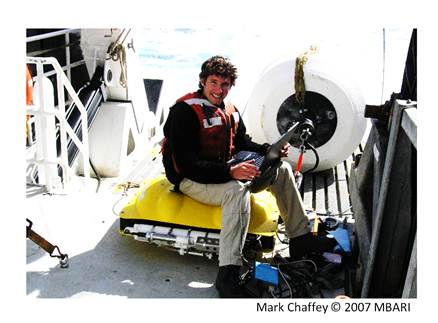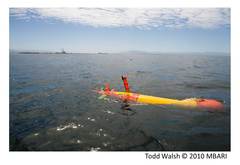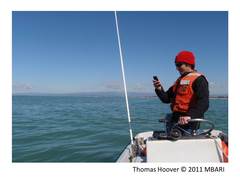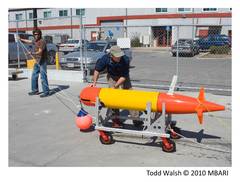
Name Brian Kieft
- Education B.S. Computer Science, Hope College, Holland, MI.
- Target Audience Middle School

Software Engineer Brian Kieft put his technical skills to work by diving into deep sea research at the Monterey Bay Aquarium Research Institute. So, read on to learn why Kieft's innovative field of ocean exploration floats our boat!
I have been a software engineer at Monterey Bay Aquarium Research Institute (MBARI) since 2006. During my time at
Currently, I'm part of a team of engineers developing the long range AUV, which is designed for upper water column biological sensing. Apart from actually writing software, I do quite a bit of systems integration, troubleshooting, and design work. The long range AUV has specific requirements to ensure it is capable of being deployed for long durations without a ship. This means that when it's operating 500 km from shore, it needs to be reliable and fault-tolerant enough to return home. Software engineering at MBARI is about much more than just programming at a desk. On any given day I'll read a lot of schematics, as well as run a boat, oscilloscope, and a compiler.
I've always enjoyed designing and building things, as well as figuring out how things work. When I was in grade school I recall an engineer visiting the class to talk about a new invention he had made for processing vegetables. It was the first time I realized that "engineer" was a word for "someone who builds new things". I always really liked fooling around with electronics and building kits or repairing car stereo amplifiers. Despite pursuing a degree in computer science, I spent a great deal of time in electronics classes and always enjoyed writing software for anything I could get my hands on. I originally took a job in the avionics industry and worked on military aircraft for five years, but oceanographic engineering is a much more exciting fit for me.
Thankfully there is no average day which keeps things really interesting. The one common denominator seems to be that my days are too short to complete everything I would like to finish. Here's a summary of a recent Tuesday at work.
 At 2:00 a.m. I received a text message from one of our offshore AUVs. Since I was the person on watch for the graveyard shift, it was my responsibility to make sure the mission was going smoothly overnight. The text notified me that the AUV had finished a portion of the mission and needed to come in for recovery to charge the batteries. I got out bed, sent a command to the robot to begin driving home and got back in bed for a few more hours of sleep. In the morning, I woke up, carpooled to work and checked the position of the AUV to make sure the robot followed my command from the night before. Mission success! The robot followed my command and made it back to the rendezvous point, which is 1 km from the harbor. I calculated its time of arrival, checked the marine forecast and then grabbed a much needed cup of coffee before moving onto my next task. Around 10:00 am I headed out on skiff to recover the AUV. Using the data it provided over a satellite link we were able to obtain its exact position once it came to the ocean surface. Recovering the AUV is one of many really exciting aspects of my job, because I often get to see whales, dolphins, or sea otters as an added bonus while waiting for the vehicle to come to the surface. Since the AUV is so heavy, we have to use a crane when we need to get it back to the lab. In order to troubleshoot any instrument problems with the AUV, we have to sink it in a test tank full of sea water, so it thinks it's in the ocean. We knew the AUV experienced a ground fault at sea, so we tried to isolate that by running a software program designed to identify electrical problems. Unfortunately, the software we used did not resolve the issue, so I had to use a more manual method of unplugging connectors to isolate the fault. Finally, we discovered the ground fault and were able to fix it. After fixing the AUV, I finished catching up on emails, worked on some papers and other smaller projects and then it was time to head home.
At 2:00 a.m. I received a text message from one of our offshore AUVs. Since I was the person on watch for the graveyard shift, it was my responsibility to make sure the mission was going smoothly overnight. The text notified me that the AUV had finished a portion of the mission and needed to come in for recovery to charge the batteries. I got out bed, sent a command to the robot to begin driving home and got back in bed for a few more hours of sleep. In the morning, I woke up, carpooled to work and checked the position of the AUV to make sure the robot followed my command from the night before. Mission success! The robot followed my command and made it back to the rendezvous point, which is 1 km from the harbor. I calculated its time of arrival, checked the marine forecast and then grabbed a much needed cup of coffee before moving onto my next task. Around 10:00 am I headed out on skiff to recover the AUV. Using the data it provided over a satellite link we were able to obtain its exact position once it came to the ocean surface. Recovering the AUV is one of many really exciting aspects of my job, because I often get to see whales, dolphins, or sea otters as an added bonus while waiting for the vehicle to come to the surface. Since the AUV is so heavy, we have to use a crane when we need to get it back to the lab. In order to troubleshoot any instrument problems with the AUV, we have to sink it in a test tank full of sea water, so it thinks it's in the ocean. We knew the AUV experienced a ground fault at sea, so we tried to isolate that by running a software program designed to identify electrical problems. Unfortunately, the software we used did not resolve the issue, so I had to use a more manual method of unplugging connectors to isolate the fault. Finally, we discovered the ground fault and were able to fix it. After fixing the AUV, I finished catching up on emails, worked on some papers and other smaller projects and then it was time to head home.
Some days my job is very field heavy , so I spend almost all day on the water or working on the AUV's. Other days I spend most of my time doing less exciting office work . My work depends on what the priority is on any given day.
Some people have a job that's been around for a long time and is fairly understood, like a banker, mechanic, pilot, or fire fighter. The techniques and procedures for the job are usually well defined. I enjoy having a job that few people have done before. Sometimes this leads to failures or dead ends, but having the freedom to be creative and try new things makes it exciting to come to work every day. I also have the opportunity to teach a tutorial on AUVs at conferences throughout the year and occasionally present papers. Having an office on the beach and being able to surf at lunch is a nice perk too!
fighter. The techniques and procedures for the job are usually well defined. I enjoy having a job that few people have done before. Sometimes this leads to failures or dead ends, but having the freedom to be creative and try new things makes it exciting to come to work every day. I also have the opportunity to teach a tutorial on AUVs at conferences throughout the year and occasionally present papers. Having an office on the beach and being able to surf at lunch is a nice perk too!
Science was always my favorite subject in school and I particularly enjoyed experiments, dissections, etc. The hands on activities always intrigued me.
I always struggled with math throughout school, but I learned at a fairly young age that math is really the language of science. So, if I was going to continue with a science field, I had to learn and understand math to be successful.
My parents always encouraged learning, building, and experiments as I grew up and I was involved with everything from science fairs to go carts. Teachers throughout high school also encouraged my interests largely in extracurricular activities. We'd discuss physics while setting up rock climbing anchors or I'd have a chance to earn extra credit building a protein skimmer for the fish tanks in marine biology class. Learning real world applications of what was being taught in class really helped and inspired me to pursue a technical field.
Middle school is a great time to begin pursuing individual interests. Join a club or take on a project! I began getting involved in photography at this age largely because I enjoyed the technical aspect. I was rewarded with an introduction to the artistic side photography which is much more about creating an image and telling a story than taking a picture. Also, any science, math or engineering courses in high school will help you in college. Not all high schools offer engineering, but you can supplement this subject with shop class or extracurricular activities life robotics club.
The field of underwater robotics is growing rapidly. Batteries with much higher power densities are now available and many more low power electronics and processors are on the market. As the cost of operating ships increases and the need for more persistent ocean observation increases, the field of underwater robotics will continue to grow. Areas such as defense, oil field monitoring or environmental monitoring are demanding more innovation in ocean observation which will include more precise onboard underwater navigation and higher bandwidth over the horizon communications.
Ocean exploration is not a new field, but the robotics and technology used to explore the ocean is new. When I was a kid, software engineers were pretty much confined to desk jobs. Only recently has software engineering infiltrated deep sea exploration and I feel really fortunate to be a part of this change. I advise kids to figure out what they're interested in, which may be an industry that doesn't even exist yet. Sometimes it's not about fitting in, it's about making your place.
(adapted from mbari.org)
Amplifiers - a thing for enlarging power
Autonomous Underwater Vehicles (AUVs) - underwater robot vehicle, not designed to carry humans
Avionics Industry - development and use of electrical and electronic devices in aviation
Benthic Instruments - Tool designed for use on the ocean floor
Compiler - a program used to transform one computer language into another computer language
Crane - lifting machine: a large machine used to lift and move heavy objects
Ground Fault - the accidental, grounding of a conducting wire
Long Range AUV - underwater robot vehicle designed for long terms underwater use - months.
Mooring Controllers - an embedded computer that records information from oceanographic instruments moored on the seafloor or on a floating buoy at the surface. The controller also provides the data to shore via a satellite link.
Oscilloscope - an instrument for producing a visual recording of an electrical wave
Remotely Operated Vehicles (ROVs) - underwater robots that are tethered to a mother ship and are controlled from onboard that ship
Schematics - diagrams, plans, or drawings
Skiff - any of various types of boats small enough for sailing or rowing by one person
Systems Integration - combining multiple systems
Upper Water Column Biological Sensing - examining the top of a column of water from surface to bottom
(adapted from dictionary.com)
Meet Wen-lu Zhu! She works as a scientist studying deep sea rocks in hy…